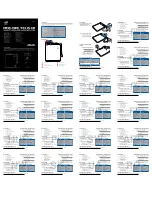
2
INSTALLATION GUIDE
2.2.3 Mounting the Battery Sensor
The length of cables on the Battery
Sensor to connect to the Main Unit
and the House Battery will dictate
the allowable mounting distance
from the battery.
The Battery Sensor should be
mounted to a solid surface using
two suitably sized screws for
attachment.
Figure 2.2.3.1 illustrates how to mount the Battery Sensor.
2.3 DC Cable Size Requirements
Batteries are capable of providing very large currents in the case of a short circuit. A fuse
must be installed on the positive wire outputs as close as practical to each battery. Failure
to do so provides inadequate protection against fire in the case of a short circuit. The
installer is responsible for ensuring that the correct cable and fuse sizes are used when
installing this Battery Charger.
The Manager15 is capable of drawing up to 30A from the Vehicle Battery (which
may be several metres from its installation location) and is limited to 15A output
to the House Battery.
Prior to installation:
• DC input and output cables should be as short as possible (preferably no
longer than the values shown in table 2.3.1 & 2.3.2)
• The size of the cable should be thick enough to maintain a voltage drop
of less than 3% when carrying the maximum input current. This will help
prevent frequent low-input voltage warnings, shutdown and poor charging
performance. The Manager15 will operate with less efficient cabling however
for best performance, high-quality cable connections should be used to
minimise voltage drop and efficiency losses
• The following sizes of cables and fuses are recommended for connection of
the DC cables batteries to Manager15, see table 2.3.1 & 2.3.2 over the page
for suitable cable sizing for your installation.
16
Figure 2.2.3.1 - Mounting the Battery Sensor
Содержание BMS1215S3
Страница 1: ...Battery Management System BMS1215S3 THE MANAGER ...
Страница 37: ...4 REMOTE DRILL TEMPLATE 36 ...
Страница 38: ...37 THIS PAGE INTENTIONALLY LEFT BLANK ...
















































